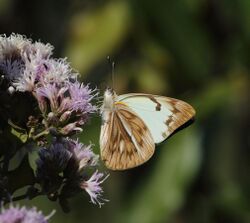Biology:Distephanus
| Distephanus | |
|---|---|

| |
| D. angulifolius flowers being pollinated by the African veined white butterfly | |
| Scientific classification | |
| Kingdom: | Plantae |
| Clade: | Tracheophytes |
| Clade: | Angiosperms |
| Clade: | Eudicots |
| Clade: | Asterids |
| Order: | Asterales |
| Family: | Asteraceae |
| Subfamily: | Vernonioideae |
| Tribe: | Vernonieae |
| Genus: | Distephanus Cassini |
| Type species | |
| Distephanus populifolius | |
| Synonyms[1] | |
| |
Distephanus is a genus of flowering plants in the family Asteraceae.[2] It is described by American botanist Harold E. Robinson as having over 40 species [2] and by David Mabberley as having only 34 species.[3] These sources differ sharply in their description of the range of the genus. Robinson has it ranging throughout Africa and occurring also in India and China . Mabberley has it restricted to southeast Africa, Madagascar , and Mauritius.
The genus Distephanus consists of trees, shrubs, and vines. The leaves are often trinervate. The flowers are in terminal inflorescences and are usually yellow. The anthers have an appendage called a tail. The base of the style is enlarged.
The name Distephanus is derived from Greek and means "two crowns", a reference to the two whorls of bristles that form the pappus.[4]
The genus Distephanus was established by Alexandre de Cassini in 1817.[5] Cassini described the type species, Distephanus populifolia in 1819.[6] This species had originally been named Conyza populifolia by Jean-Baptiste Lamarck in 1786.[7]
Distephanus has usually been placed in the tribe Vernonieae, but the results of some molecular phylogenetic studies of DNA sequences have cast doubt upon this placement. In one classification of Asteraceae, it was placed in a tritomy consisting of Distephanus, Moquinieae, and Vernonieae.[8]
Distephanus differs from (other) genera in Vernonieae in having yellow flowers as well as in other characters that are less obvious.[9]
Species
Species include:[10]
References
- ↑ Flann, C (ed) 2009+ Global Compositae Checklist
- ↑ 2.0 2.1 Harold E. Robinson. 2007. "Vernonieae" pages 149-174. In: Klaus Kubitzki (series editor); Joachim W. Kadereit and Charles Jeffrey (volume editors). The Families and Genera of Vascular Plants volume VIII. Springer-Verlag: Berlin; Heidelberg, Germany. ISBN:978-3-540-31050-1
- ↑ David J. Mabberley. 2008. Mabberley's Plant-Book third edition (2008). Cambridge University Press: UK. ISBN:978-0-521-82071-4
- ↑ Umberto Quattrocchi. 2000. CRC World Dictionary of Plant Names volume II:822. CRC Press: Boca Raton; New York; Washington, DC;, USA. London, UK. ISBN:978-0-8493-2676-9. (vol. 2). (see External links below).
- ↑ Alexandre H.G. de Cassini. 1817. Bulletin des Sciences, par la Société Philomatique de Paris. (1817):151.
- ↑ Alexandre H.G. de Cassini. 1819. Dictionnaire des Sciences Naturelles, ··· Strasbourg. edition 2. (F. Cuvier). 19:361.
- ↑ Jean-Baptiste Lamarck. 1786. Encyclopedie Methodique. Botanique ··· Paris. 2(1):87.
- ↑ Vicki A. Funk, Alfonso Susanna, Tod F. Stuessy, and Randall J. Bayer. 2009. Systematics, Evolution and Biogeography of the Compositae. IAPT (International Association for Plant Taxonomy). ISBN:978-3-9501754-3-1 (see External links below).
- ↑ Harold E. Robinson. 1986. "Trinervate leaves, yellow flowers, tailed anthers, and pollen variation in Distephanus Cassini (Vernonieae: Asteraceae)". Proceedings of the Biological Society of Washington 99(3):493-501.
- ↑ "The Plant List: A Working List of All Plant Species". http://www.theplantlist.org/tpl1.1/search?q=distephanus. Retrieved September 17, 2014.
- ↑ H. Rob. & V.A. Funk. 2012. Taxon 61(2): 452
- ↑ Norbert Kilian and Anthony G. Miller. 2000. Studies in the Compositae of the Arabian Peninsula and Socotra - 5. Distephanus qazmi (Vernonieae, Gymnantheminae), a remarkable new species from the island of Socotra, Yemen. Willdenowia 30(1):83-91.
External links
- Distephanus At: Index Nominum Genericorum At: References At: NMNH Department of Botany At: Research and Collections At: Smithsonian National Museum of Natural History
- Classification (compositae book, chapter 11 At: The International Compositae Alliance
- CRC World Dictionary of Plant Names: D-L At: Botany & Plant Science At: Life Science At: CRC Press
Wikidata ☰ Q5234174 entry
 |

